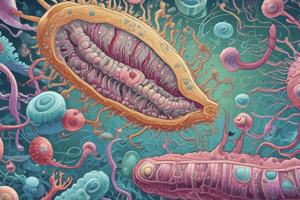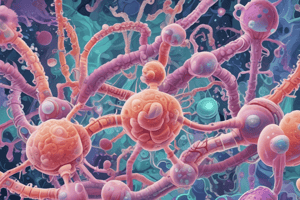Podcast
Questions and Answers
Quales methodos non es implicate in le detection de bacterias?
Quales methodos non es implicate in le detection de bacterias?
- Test de WIDAL
- Inoculation animal (correct)
- Microscopie fluorescent
- PCR
Quale media de cultura es typic in le identification de fungos?
Quale media de cultura es typic in le identification de fungos?
- Blood agar
- Luria-Bertani agar
- MacConkey agar
- Sabouraud's dextrose agar (correct)
Quale de le sequente non es un methodo molecular pro detection de virus?
Quale de le sequente non es un methodo molecular pro detection de virus?
- Reverse transcriptase-PCR
- PCR
- Gram stain (correct)
- Real-time RT-PCR
Quale affirmation sobre le test de immunodiagnostica per parasitas es falsa?
Quale affirmation sobre le test de immunodiagnostica per parasitas es falsa?
Quale methodo non es usate pro le detection de antigenos virales?
Quale methodo non es usate pro le detection de antigenos virales?
Quale description de microscopie non es correcta?
Quale description de microscopie non es correcta?
In le process de identification de bacterias, quales methodos non son automatizados?
In le process de identification de bacterias, quales methodos non son automatizados?
Quale non es un methodo usate per isolation de virus?
Quale non es un methodo usate per isolation de virus?
Flashcards
Bacteriological Diagnosis
Bacteriological Diagnosis
Methodes for identifying bacterial infection by collecting specimens, direct observation, culture, biochemical testing, and antimicrobial susceptibility.
Microscopy for Pathogens
Microscopy for Pathogens
Using microscopes (light, fluorescence, electron) to observe and identify bacteria, fungi, parasites (and viruses indirectly) in a sample to determine diseases.
Fungal Culture Methods
Fungal Culture Methods
Cultivating fungi on specific culture medias (Sabourauds, etc.) under controlled conditions for identification, and diagnostics, including temperature and time-dependent growth parameters.
Viral Detection Methods
Viral Detection Methods
Signup and view all the flashcards
Parasitic Feces Examination
Parasitic Feces Examination
Signup and view all the flashcards
Molecular Diagnostics
Molecular Diagnostics
Signup and view all the flashcards
Specimen Collection Protocols
Specimen Collection Protocols
Signup and view all the flashcards
Identifying Bacteria - Automation
Identifying Bacteria - Automation
Signup and view all the flashcards
Study Notes
Lab Diagnosis: Bacteria
- Specimen collection: Table in pg no. 23
- Direct detection: Microscopy (Gram stain, acid-fast, Albert, histopathological, dark ground, phase-contrast, fluorescence) and antigen detection from clinical specimens, molecular diagnosis (detecting bacterial DNA or RNA from clinical specimens)
- Culture: Culture media, culture method, colony morphology, smear and motility testing.
- Identification: Biochemical identification, automated identification methods (VITEK, MALDI-TOF)
- Antimicrobial susceptibility testing
- Serology: WIDAL, VDRL, ELISA
- Molecular methods: PCR, rt-PCR, CBNAAT
- Typing methods: Phenotyping and Genotyping
Lab Diagnosis: Fungi
- Specimen Collection
- Microscopy: KOH preparation, Gram stain, PAS stain
- Culture: Culture media (Sabouraud's dextrose agar, Neutral SDA agar, BHI agar, blood agar), Culture condition (temperature, BOD incubators), Culture identification
- Immunological Methods: Ag detection, Ab detection, IHC
- Automations: VITEK, MALDI-TOF
- Molecular Methods: PCR
Lab Diagnosis: Viruses
- Direct Demonstration of Virus: Electron, Immunoelectron, Fluorescent, Light microscopy (histopathological staining, demonstrating inclusion bodies, immunoperoxidase staining)
- Detection of Viral Antigens: ELISA, ELFA, direct-IF, ICT, flow-through assays
- Detection of Specific Antibodies: ELISA, ELFA, ICT, flow-through assays
- Molecular Methods (detecting viral genes): PCR (DNA detection), Reverse transcriptase-PCR (RNA detection), Real-time PCR (quantifying DNA), Real-time RT-PCR (quantifying RNA)
- Isolation of Virus: Animal inoculation, Embryonated egg inoculation, Tissue cultures (organ, explant, cell line—primary, secondary, continuous)
Lab Diagnosis: Parasites
- Specimen Collection, Examination of feces (Macroscopic, Microscopic—direct wet mount, saline mount, iodine mount )
- Concentration techniques (sedimentation, floatation)
- Egg counting Methods
- Examination of blood (direct wet mount, blood smears, quantitative buffy coat)
- Microscopic examination of other specimens (Table in pg no.94)
- Immunodiagnostic Methods (Ab, Ag detection tests)
- Molecular methods (PCR, LAMP, BioFire Film Assay)
- Other Diagnostic Modalities: Culture techniques, Animal inoculation methods, Imaging techniques
Studying That Suits You
Use AI to generate personalized quizzes and flashcards to suit your learning preferences.




